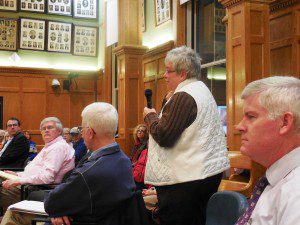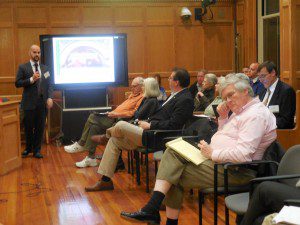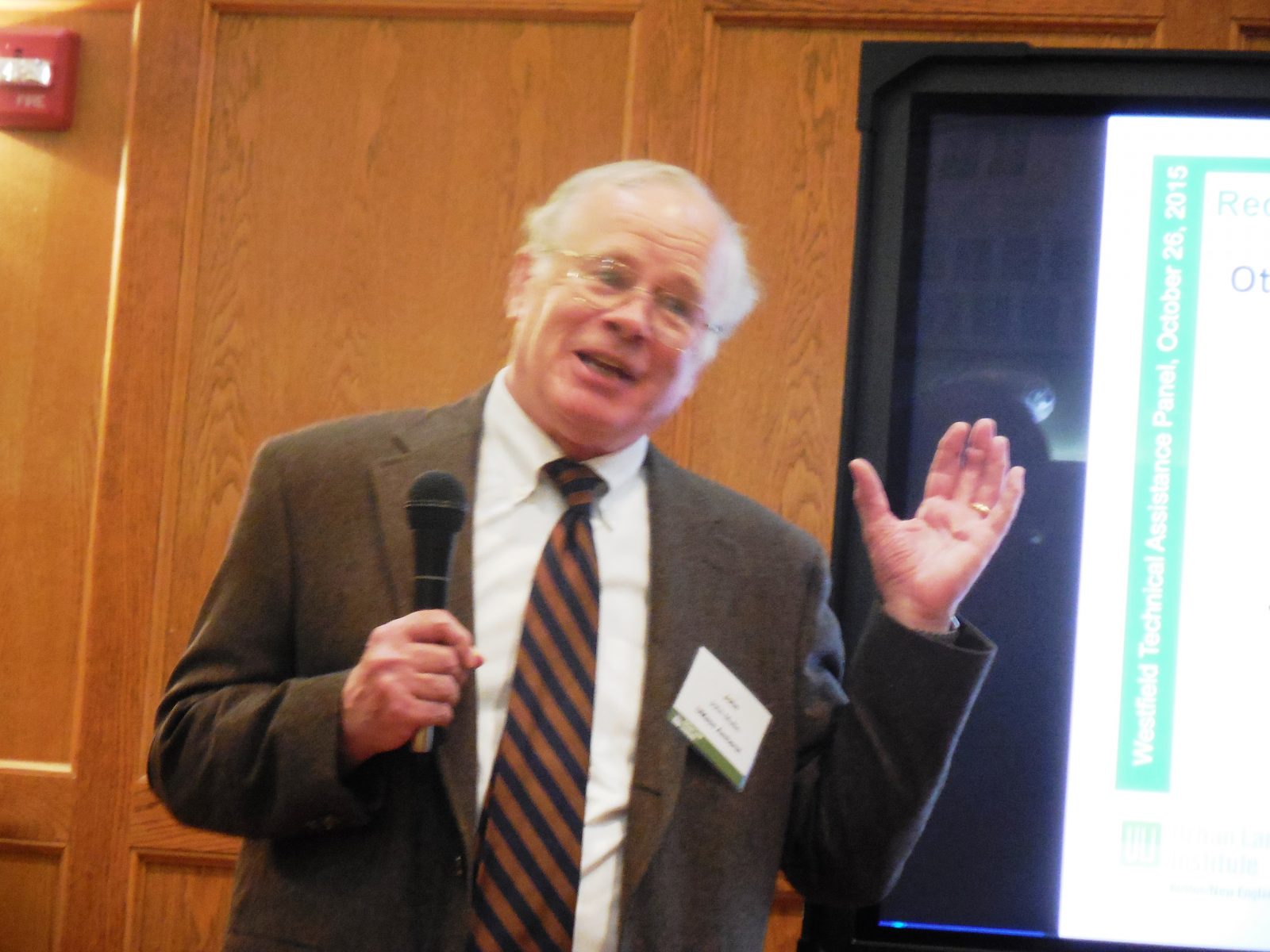
Westfield residents asked questions following the Urban Land Institute presentation last night. (Photo by Amy Porter)
WESTFIELD – A panel of experts in community development, engineering, real estate and planning brought together by the Urban Land Institute spent yesterday touring downtown, the university and the riverfront, speaking to business owners and residents, and gathering their impressions of Westfield into a presentation that was shared with the public in the City Council chambers.
Jim Heffernan, an attorney with Partridge, Snow & Hahn in Providence, RI, said that prior to the visit the group had received a briefing book on Westfield redevelopment from Community Development Director Peter Miller. Heffernan said the visit was an opportunity for an outside group to offer feedback and ideas.
Scott Payette, of the Initiative for Competitive Cities, ran down some of the assets that the group observed on their tour. “You may already know, but hearing it from an outsider, it’s beautiful,” he said.
He talked about the rivers and the bike path, which he called, “a huge generator of interest.”
He called Westfield a city with a small town feel, good schools and a safe environment where “people know each other.” He described good housing stock and low rents and utilities, being close to the turnpike, with a stable and growing population. He also noted the available senior housing, and proximity to the hospital.

Jim Heffernan, chair of the Urban Land Institute panel, takes questions at the end of last night’s presentation. (Photo by Amy Porter)
Westfield has “wonderful physical assets,” Payette said. “You have the opportunity to be the gateway to the hilltowns.”
John Mullin, a professor of regional planning and director of the Center for Economic Development at the University of Massachusetts in Amherst, talked about conversations with stakeholders. He said the common themes raised included market leakage, with residents going outside of Westfield to shop. He suggested attracting a national retailer anchor tenant downtown, and mentioned Whole Foods as an example, which residents said they drive 45 minutes to get to.
Mullin also noted the lack of entertainment venues in town. He said a downtown has to be active 16-17 hours a day, from 6 a.m. – 11 p.m.
Mullin said other concerns raised by stakeholders included the need for more support of local businesses, in particular regarding traffic and snow removal. Absentee landlords and the gradual degradation of their properties were also mentioned. Another concern was parking, and whether the proposed PVTA transit pavilion was a good idea, which he said had mixed reviews.
Mullin said he had a highly positive response from stakeholders to the question of whether they were better off now than ten years ago.
John Markowitz of MassDevelopment added that a key issue for residents is investment by Westfield State University in the downtown. This relationship was mentioned by speakers throughout the presentation. They talked about the opportunities now that there will be a new mayor and council, and a new president at Westfield State University, to develop a new foundation for a town-gown relationship.
Another theme picked up on by many speakers was the opportunity presented by the 14-mile Columbia Greenway rail trail and the city’s historic ties to cycling through Columbia Bikes. Navaneeth Raj, of Mansard Commercial Properties said the rail trail should be on every website that has anything to do with cycling. He talked about having food and bike shop pop-ups, or seasonal businesses, at the head of the trail. Another speaker suggested hosting a bike circuit race, and family bike rides and races.
Several speakers suggested revisiting the business improvement district (BID), which Mullin called “a germ of an idea here still worth exploring.”
They said business people are frustrated by the great number of plans that have been developed. Mullin said that Pittsfield has established a voluntary business association.
Another suggestion was to update the overall assessment of the market area, which was last done in 2009, to find out the amount and extent of market leakage. Russ Burke of the BSC Group in Boston said that this kind of data would be persuasive in order to get a national chain interested in the downtown area.
The group also felt that better signage from the Mass. Turnpike was needed directing people to downtown, and stressing some of the historical aspects of the city, such as the Knox Trail.
“A lot of what we’re talking about is building on the significant investment you’ve already made,” Burke said. “How do you leverage those investments as you move forward?”
During a question and answer portion, the group was asked if there was a model they might consider. Mullin said Keene, NH was one. Keene developed a task force to tie Keene State with the downtown. They did a market study on how much students were spending and where, and began to attract them. They also landscaped the city, and planted trees downtown.
The question of how to bring cyclists into downtown was raised, noting that the streets are not very bike friendly. One panelist suggested studying an organization called Livable Streets, which works to increase safe biking and walking culture all around the U.S. A member of the Greater Westfield Chamber of Commerce also spoke up, saying the organization will be hosting a round-table on bike safety in November.
Another resident asked how to take the ideas and get them into a working phase. He said that this was the third time a group had come and discussed the assets of Westfield, and he was tired of the discussion aspects.
“Keep going,” Mullin said. “You’re closer than you’ve ever been.”
He said with the transition of leadership, there will be opportunities, but the residents must keep up the pressure.
“The conclusion I came to is there isn’t adequate clarity on what makes you unique, special and different.,” Raj said. “When you understand that, and can communicate it, I believe you’ll have people lining up.”


